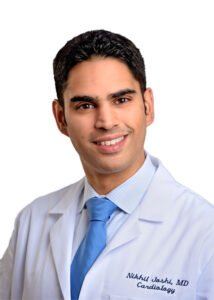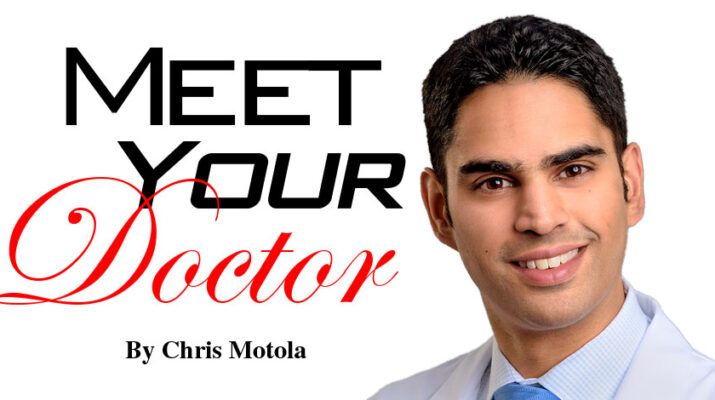Crouse cardiologist specializes in electrical problems in the heart. He discusses pacemakers, defibrillators and why even young people have heart problems
By Chris Motola

Q: What does your practice cover?
A: Currently we have a group of 12 cardiologists. The practice has been around for several decades. It used to be a private practice but shortly before I joined they developed an affiliation with Crouse Hospital and became part of the Crouse Medical Practice. So it’s a mix of non-invasive, general cardiologists, interventional cardiologists who do stenting procedures and myself and one other cardiologist who do electrophysiology. That’s putting in devices like pacemakers and defibrillators and doing procedures called ablations for irregular heartbeats.
Q: What do modern pacemakers look like? How big are they?
A: Overall, the newer ones are pretty small. The diameter is less than if you made a fist with your hand, and the thickness is on the order of a few centimeters. Decades ago it was a big device that you had to wear on your abdomen. The first ones you even had to be physically connected to something. But the new ones have come a long way in battery technology. We can even monitor them remotely without the patients in the office.
Q: So it directly transmits the information to providers?
A: Yeah, there’s three or four different companies that make them, and they each have their own servers that do the monitoring. And we enroll the patient if both the physician and patient are interested in periodic transmissions, which gives us basic information about the devices. It can help us decide if we need to see them or not, which is especially helpful with the state of things now with coronavirus.
Q: How does the data compare to what you’d be able to get in person?
A: It’s similar to what you could get in person. Sometimes there are subtleties to the checks that are better done in person, and you can’t make any programming changes from the remote visits. That’s why we try to see the patients regularly in the office. The remote monitoring just adds some extra data on top of that.
Q: What does your patient base look like in terms of ages?
A: I really see quite a broad mix. Electrical problems can be present from childbirth. Kids can be born with abnormal heart rhythms. There’s a pediatric subspecialty in my field as well. I’ll see patients as young as 16 or 17. In terms of pacemakers, it’s generally patients who are older, but we do see some patients who need them who aren’t as old. So I’d say from 16 to a few patients over the age of 100 who are still active. So it’s really a pretty big range of patients with these electrical issues, even if their heart is otherwise normal.
Q: Rumor has it you’re a hit with the younger patients.
A: Yeah, I guess I didn’t realize that. I’m not the youngest in the practice, but I’m on the younger end. That may be why. We have a few different ways for patients to communicate with us, like through the patient portal where you can sign up and communicate digitally. Patients of all ages use it, but the younger ones seem to like it the most. So I communicate with them through that. Beyond that? I’m not sure there’s anything really unique that I do that draw them to me. You do sometimes get patients telling you they prefer a younger doctor because you’re not going to retire anytime soon.
Q: Where do electrical problems in the heart come from? How do they develop?
A: Sometimes you’re born with it. Some people can, rarely, be born with an extra “cable” on the microscopic level, which conducts electricity to the heart. Those cables can generate abnormal rhythms. With older patients sometimes it’s the accumulation of scar tissue over time, whether from a heart attack or diabetes, or high blood pressure, or they are very overweight. One of the most common ones is atrial fibrillation, and it’s more common in the U.S. than other countries, which speaks to their being some kind of lifestyle component, whether it’s higher stress, dietary or exercise. It’s a pretty big burden on health care costs.
Q: What effect is COVID -19 having on your patients’ heart health?
A: We’re definitely seeing issues. Many of our patients fall under the high-risk category for COVID. Most have done a good job of wearing masks and socially distancing. Many of the snowbirds who would normally spend the winter somewhere warmer have stuck around this year to avoid travel. We’ve done a lot of telemedicine to give patients an option to be seen remotely. But we have had patients with COVID who came in extremely sick, but we don’t see too many, because they usually are treated in the ICU. You do hear about some young and healthy patients who get a very bad case and develop heart issues, whether arrhythmia or anything else.
Q: Do you do screenings as well?
A: I see patients of all different types, but I usually get referred patients whose symptoms suggest some kind of electrical problem, whether it’s their heart racing, or palpitations, or have been fainting. But I do also see patients who are monitoring their blood pressure and general issues.
Q: When should a patient think about seeing someone in your subspecialty?
A: With younger patients they can tend to come on like a light switch. One moment you’re feeling fine, and then the next you feel your heart racing, or a lump in their threat or neck, or feel like they’re going to pass out in extreme cases. These are very general symptoms, so sometimes we’ll run tests and not really find anything. But once in awhile we do.
Lifelines
Name: Nikhil Joshi, M.D.
Position: Clinical cardiac electrophysiologist at Crouse Hospital
Hometown: Pittsford
Affiliations: Crouse Medical Practice , Crouse Hospital
Education: Bachelor’s degree: Johns Hopkins University, Baltimore; Medical school: Stony Brook University School of Medicine, Stony Brook; residency: University of Rochester Medical Center, Rochester; board certified in cardiovascular disease, internal medicine; fellowship in cardiovascular disease, Thomas Jefferson University Hospital, Philadelphia; fellowship in cardiac electrophysiology, Thomas Jefferson University Hospital, Philadelphia
Organizations: American College of Cardiology; Heart Rhythm Society; American Board of Internal Medicine
Family: Wife, two daughters
Hobbies: Time with family, golf, tennis

